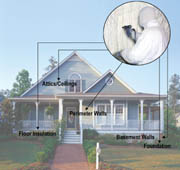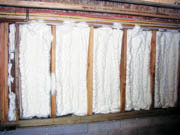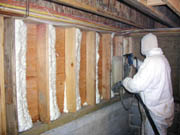
The new insulation technology will protect against moisture, sound, odors, air pollution and even structural damage-insulation that could make traditional fiberglass batts a thing of the past.
"The wave of the future is sprayed-in place polyurethane foam," says Craig DeWitt, Ph.D., P.E., and president of RLC Engineering, of Clemson, S.C. "The use of SPF offers potential for enhancing not only the thermal efficiency of residential structures, but important structural benefits and the potential for significant improvements in quality of residents' lives."
DeWitt, who has worked in the field of structural design, building materials and technologies, and HVAC issues for more than 25 years, is among the growing number of experts who are taking a broader view of the health, safety and comfort requirements of residential living, requirements that can often be greatly enhanced through the use of advanced SPF insulation techniques.
Others who are catching the SPF wave include architects, general contractors and entrepreneurs who see the use of SPF as a tremendous business opportunity that is likely to continue growing for decades.
"Homeowners are becoming increasingly inclined to request SPF insulation," adds Steve Loftis, Marketing Manager for North Carolina Foam Industries, a supplier of polyurethane chemicals since the "early days" of SPF in the 1970s.
"Through word of mouth, exposure on TV shows such as This Old House and the availability of information on the Internet, a growing number of homeowners are asking their architects and builders to incorporate polyurethane foam insulation into their houses," Loftis says.

Spray it
In a nutshell, SPF is polyurethane foam sprayed from a gun onto a surface, such as wallboard and plywood sheathing, or into a cavity such as an enclosed wall or crawlspace. It can be used throughout the interior or exterior of a structure, depending on needs. SPF can be applied in a variety of densities, also depending on structural requirements and benefits sought. Some SPF is applied from portable units (hydraulic- or air-powered), but many contractors use dedicated, self-contained truck-mounted systems.Generally speaking, SPF costs more than conventional fiberglass batts. But the additional up-front costs can be overcome by the other benefits of SPF, such as reduced utility costs due to enhanced thermal insulation, increased structural strength and reduced air and water infiltration. Other benefits, such as reduced sound and odor penetration, may also be of value.
"This is a tremendous growth market," says Pete Rushing, of Gusmer Corp., a major supplier of SPF and other polyurethane spray, pour and injection equipment. "We have just seen it begin to take off in the past decade. Today, the acceptance is nationwide."
Not only does SPF offer several added benefits over fiberglass insulation, it does a better job than traditional thermal insulation.
"The conventional R-value rating system used for insulation is based solely on conduction, or heat transfer through an object or between objects in contact," DeWitt explains. "But when we use SPF, we can protect against convection (heat transfer when a liquid or gas comes in contact with a material) and also radiation (transfer of heat by waves-not requiring contact). Also, when using fiberglass batts, R-values can differ widely in the field, especially if some batts are improperly installed. For example, an R-13-rated batt may only provide R-9 insulation. Whole wall R-values may be even less because of voids," he says.
"SPF fills up the nooks and crannies that are often difficult to reach or cover uniformly," adds Loftis. "These can cause thermal leakage that can result in increased heating and air conditioning costs."
In the past, air infiltration and intrusion were often viewed as secondary or even overlooked when insulation was considered. Air infiltration, where air literally bypasses insulation, allows heat and cold transfer through the flow of air between the exterior and the interior of the structure. Air intrusion, also known as "wind wash," occurs when air enters the insulation from the exterior and draws off heat or cold air from the interior through the insulation. Air intrusion can substantially undermine the effective R-value of conventional insulations.
Users of conventional batt insulation frequently use "house wraps" and vapor retarders in an attempt to seal in air and reduce air infiltration. SPF prevents air penetration even under the pressure differences buildings frequently experience, thereby preventing both air infiltration and intrusion.

Added structural benefits
Clemson University, of Clemson, S.C., has been researching the use of SPF as an enhanced attachment system for roofing, says DeWitt, who worked with the university's extension system for 20 years."This research centers on how to construct or retrofit buildings to be more resistant to hurricanes or other high winds events. Clemson's research shows that SPF can significantly improve the attachment of roof sheathing to trusses and rafters, similar to the way that construction adhesives help bond a floor system together," he says. It should be noted that although low-density "open cell" foam (typically 1/2 pound per cubic foot) will hold in high winds, high-density "closed cell" foam (typically 2 to 3 pounds per cubic foot) is ideal for such applications.
NCFI's Loftis points out that high-density "closed cell" SPF will not allow water to pass through it, and is approved by the Federal Emergency Management Agency as a flood-resistant material.
"SPF offers significant advantages anytime a dwelling is possibly going to come into contact with water. So, along the beach near oceans and lakes where there are high winds and high water, where you have blowing water hitting the exterior of a house, the foam is not going to allow water to penetrate into the doors, windows, roofs or wall assemblies," Loftis says. "Houses with fiberglass batts not only don't hold up to blowing water, but when they become water damaged the owner must be prepared for a very costly tear-out of all the old insulation and installation of new material."
"You get a monolithic effect (acting as a rigid, uniform whole structure) when you spray an attic or walls with SPF," says Stan Betts, president of Foam Tight Insulation, of Ocean, N.J. "Because you're closing everything off with the foam between each stud cavity, going from stud section to stud section across the sheathing, you're effectively making it a monolithic seal, and the air can't penetrate it."
SPF is not commonly used as exterior roofing material for residential structures, but it is routinely used underneath roofing such as tiles and shingles. But when used on top of the roof-the actual roofing membrane-it is extremely strong. This is done very often on roofs that are flat, low sloped or domed, where shingles may not be a good choice. The foam used in such situations would typically be of 3-pound density.
Although SPF is most commonly used in wood and metal structures, it can be used to insulate concrete block walls and concrete foundations. In some dwellings the foam is shot into concrete blocks after every eight courses or so are set in place. SPF can also be applied to the outside of block walls, after which brick, stone or stucco is applied, creating a thermal "sandwich" air barrier.
Such air barriers have been promoted for commercial building codes by the Air Barrier Association of America for a number of years. It is likely that many local and state building codes will soon require air barriers, at least in commercial buildings. This is because effective air barriers greatly improve building efficiencies in both cold and warm climates, plus promote overall envelope performance.
According to the U.S. Department of Energy, up to 40 percent of the energy consumed to heat or cool a building is due to air leakage into and out of the structure. Considering that the leakage may be even greater in many residential structures, the air barrier characteristic available through SPF is another highly attractive and cost-saving feature.
A barrier to moisture, sound, odors and molds
Moisture in air leaking into or out of a structure, commonly known as infiltration, can cause condensation, mold growth and fungal decay within exterior walls or in other parts of the building. Since SPF can stop this type of moisture movement, buildings can be healthier environments and more durable. Moisture accumulation within insulation materials will reduce that insulation's R-value, contributing to heat loss/gain. Although other methods may be used to prevent moisture accumulation, closed-cell SPF does a thorough job.Historically, roofs were ventilated in an attempt to prevent moisture problems and reduce heat build-up. Current research shows that much of the moisture in attics comes from damp basements or crawl spaces, as well as from the living space. By insulating with SPF, surface temperatures and resultant heat transfer plus moisture from condensation are virtually eliminated.
Also, because SPF is such an excellent air barrier, it minimizes unwanted guests in a dwelling, such as molds, odors and pollutants that may be present in outside air.
In the past, soundproofing was usually overlooked as an insulation requirement except in the most luxurious homes. In today's homes with media rooms, rumpus rooms and garage workshops, the soundproofing of living areas can be an important asset. Depending on thermal insulation requirements and other considerations, either low- or high-density SPF, or a mixture of both, can provide added soundproofing that will prevent noise from one room interfering with the peace of mind with those occupying other rooms in the house.
Those in search of SPF contractors will likely find them ranging from building insulation contractors to SPF specialists. In some instances, contractors may specialize in certain types of structures. For that reason, as well as others, some contractors may favor the use of low- or high-density polyurethane, or both. In fact, for some applications, the use of both types may be ideal.
The SPF specialist may offer a choice of spray foams, depending on the building design and environmental conditions. Many such specialists have truck-mounted systems, and will apply the foam at various stages of construction.
Suppliers, such as NCFI, offer contractors a full array of chemicals and spray equipment, depending on their individual needs.
"We sell the full line, including the rigs," says Loftis. "We support contractors with parts and service. We also provide training through our certified instructors. We also help new contractors evaluate what type of equipment is best for them. In some instances this means matching the SPF system with equipment they already own, for example, a generator set or air compressor, so they don't have to buy everything brand new.

Report Abusive Comment